Several power-sector CEOs—appearing at the Bloomberg New Energy Finance (BNEF) Summit in New York this week—suggested that existing nuclear power plants should not be allowed to slowly vanish from the U.S. electricity grid under market pressure caused by cheap natural gas and the growth of renewable energy. The leaders submitted that nuclear power provides important carbon-free energy needed to meet greenhouse gas (GHG) reduction goals.
“We have this issue in the U.S. around nuclear. It doesn’t compete against gas, but is a critical component of a decarbonized future,” said Audrey Zibelman, CEO and managing director of the Australian Energy Market Operator. Although Zibelman no longer resides in the U.S., she appeared to still have a vested interest in the country’s energy sector, having previously chaired the New York State Public Service Commission, and having been executive vice president and chief operating officer of the PJM Interconnection, among other things.
Ralph Izzo, chairman, president, and CEO of Public Service Enterprise Group Inc. (PSEG), said his company is highly focused on preserving its nuclear fleet. He noted that the Oyster Creek nuclear plant in New Jersey—an Exelon-owned facility—was recently decommissioned. “Megawatt-hour for megawatt-hour of lost load from that—of lost supply from that—was picked up by natural gas at half a ton of carbon per megawatt-hour,” Izzo said, implying that the GHG penalty was significant.
PSEG operates three nuclear reactors in New Jersey—the 1,173-MW Hope Creek unit and the dual-unit, 2,278-MW Salem station. The company has long been lobbying for the New Jersey Legislature to provide financial support to help keep the units economical. Some states, such as Illinois, New York, and Connecticut, have already enacted legislation to help keep in-state nuclear plants afloat, while Pennsylvania and others contemplate similar options.
“For Duke Energy, nuclear is foundational. In the Carolinas, 50% of the power comes from carbon-free nuclear,” Duke Energy CEO Lynn Good said. “Our objective is to keep those nuclear plants running as long as we can. We’re a proponent of second license renewal. But we also have to recognize with that foundation, how do intermittent resources fit on top of it?” she asked. “I have an eastern Carolina nuclear plant that we’re experimenting on flexibility. Can I take it down? I can’t load follow with it right now, but, ‘Is there some flexibility that I can put into place in the operation of that unit?’ is part of the maturing of this reliability picture,” she said. Duke Energy operates 11 nuclear units at six sites in the Carolinas with a combined generating capability of about 10,719 MW (Figure 1).
Geisha Williams, former CEO of Pacific Gas and Electric (PG&E), was interviewed during a separate session at the BNEF Summit. PG&E owns the two-unit, 2,256-MW Diablo Canyon nuclear facility, which is slated to close in August 2025. Tony Earley was PG&E’s CEO when the decision to retire the facility was first announced, but Williams was at the helm when the California Public Utilities Commission accepted the plan. Nonetheless, Williams suggested it is in the country’s best interest to preserve the existing nuclear fleet.
“I think carbon’s the enemy. I think greenhouse gas emissions are the enemy. We’ve got to be laser focused about it. How do we reduce that in the most cost-effective manner?” Williams said. “With something like 20% of the power produced in this country coming from nuclear, to sort of cast that aside would be pretty irresponsible. It’s safe. It’s clean. It’s affordable. It’s zero emission. So, I think part of our strategy—a big part of our strategy—has got to be how do we maintain, how do we retain, these nuclear reactors in play, providing its baseload power, very affordably and very cleanly, to buy ourselves time to figure out long-term what the solutions are,” she added.
“I personally believe that nuclear is very much a part of the solution,” said Williams.
—Aaron Larson is POWER’s executive editor (@AaronL_Power, @POWERmagazine).
The post CEOs Say Preserving the Nuclear Power Fleet Is Imperative appeared first on POWER Magazine.
